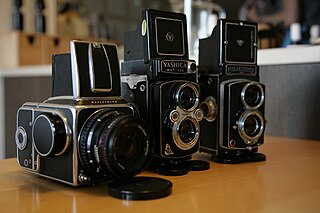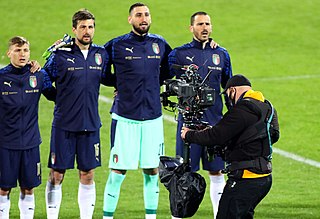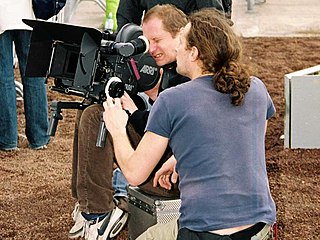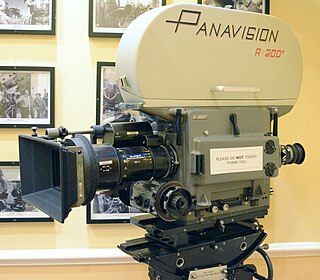
A film crew is a group of people, hired by a production company, for the purpose of producing a film or motion picture. The crew is distinguished from the cast, as the cast are understood to be the actors who appear in front of the camera or provide voices for characters in the film. The crew is also separate from the producers, as the producers are the ones who own a portion of either the film studio or the film's intellectual property rights. A film crew is divided into different departments, each of which specializes in a specific aspect of the production. Film crew positions have evolved over the years, spurred by technological change, but many traditional jobs date from the early 20th century and are common across jurisdictions and filmmaking cultures.

Medium format has traditionally referred to a film format in still photography and the related cameras and equipment that use film. Nowadays, the term applies to film and digital cameras that record images on media larger than 24 mm × 36 mm (full-frame), , but smaller than 4 in × 5 in.

A clapperboard is a device used in filmmaking and video production to assist in synchronizing of picture and sound, and to designate and mark the various scenes and takes as they are filmed and audio-recorded. It is operated by the clapper loader.

A camera operator, is a professional operator of a film camera or video camera as part of a film crew.

In the United States, Canada and the United Kingdom, grips are technicians in the filmmaking and video production industries. They constitute their own department on a film set and are directed by a key grip. Grips have two main functions. The first is to work closely with the camera department to provide camera support, especially if the camera is mounted to a dolly, crane, or in an unusual position, such as the top of a ladder. Some grips may specialize in operating camera dollies or camera cranes. The second main function of grips is to work closely with the electrical department to create lighting set-ups necessary for a shot under the direction of the director of photography.
Grips' responsibility is to build and maintain all the equipment that supports cameras. This equipment, which includes tripods, dollies, tracks, jibs, cranes, and static rigs, is constructed of delicate yet heavy duty parts requiring a high level of experience to operate and move. Every scene in a feature film is shot using one or more cameras, each mounted on highly complex, extremely expensive, heavy duty equipment. Grips assemble this equipment according to meticulous specifications and push, pull, mount or hang it from a variety of settings. The equipment can be as basic as a tripod standing on a studio floor, to hazardous operations such as mounting a camera on a 100 ft crane, or hanging it from a helicopter swooping above a mountain range.
Good Grips perform a crucial role in ensuring that the artifice of film is maintained, and that camera moves are as seamless as possible. Grips are usually requested by the DoP or the camera operator. Although the work is physically demanding and the hours are long, the work can be very rewarding. Many Grips work on both commercials and features.
In a film crew there are two kinds of best boy: best boy electric and best boy grip. They are assistants to their department heads, the gaffer and the key grip, respectively. In short, the best boy acts as the foreman for the department.

A focus puller or first assistant camera is a member of a film crew's camera department whose primary responsibility is to maintain the camera lens's optical focus on whatever subject or action is being filmed.
The role of an assistant director on a film includes tracking daily progress against the filming production schedule, arranging logistics, preparing daily call sheets, checking cast and crew, and maintaining order on the set. They also have to take care of the health and safety of the crew. The role of an assistant to the director is often confused with assistant director but the responsibilities are entirely different. The assistant to the director manages all of the directors in development, pre-production, while on set, through post-production and is often involved in both personal management as well as creative aspects of the production process.
A take is a single continuous recorded performance. The term is used in film and music to denote and track the stages of production.
Filmmaking is the process by which a film is made. Filmmaking involves a number of complex and discrete stages including an initial story, idea, or commission. Then it continues through screenwriting, casting, shooting, sound recording and pre-production, editing, and screening the finished product before an audience that may result in a film release and an exhibition. Filmmaking takes place in many places around the world in a range of economic, social, and political contexts. It uses a variety of technologies and cinematic techniques.
Principal photography is the phase of film production in which the bulk of the movie is filmed, with actors on set and cameras rolling, as distinct from pre-production and post-production.
In filmmaking, dailies are the raw, unedited footage shot during the making of a motion picture. The term comes from when movies were all shot on film because usually at the end of each day, the footage was developed, synced to sound, and printed on film in a batch for viewing the next day by the director, selected actors and, film crew members. After the advent of digital filmmaking, "dailies" were available instantly after the take and the review process was no longer tied to the overnight processing of film and became more asynchronous. Now some reviewing may be done at the shoot, even on location, and raw footage may be immediately sent electronically to anyone in the world who needs to review the takes. For example, a director can review takes from a second unit while the crew is still on location or producers can get timely updates while travelling. Dailies serve as an indication of how the filming and the actors' performances are progressing. The term was also used to describe film dailies as "the first positive prints made by the laboratory from the negative photographed on the previous day".

A changing bag is a photographic bag specifically designed to be light-proof while in use. It is required for certain applications involving photosensitive materials when a darkroom is not available, like in the field. Common usages include removing film from its canister to put it into a developing tank, or loading and unloading sheet film holders. They are also commonly found on the set of a film, where the clapper loader may need one if shooting on location or far away from a darkroom.
A script supervisor is a member of a film crew who oversees the continuity of the motion picture including wardrobe, props, set dressing, hair, makeup and the actions of the actors during a scene. The notes recorded by the script supervisor during the shooting of a scene are used to help the editor cut the scene. They are also responsible for keeping track of the film production unit's daily progress. The script supervisor credit typically appears in the closing credits of a motion picture. Script supervisors are a department head and play a crucial role in the shooting of a film. It is the script supervisor's job to monitor the camera shots, seeking to maintain coherence between the scenes.

A camera magazine is a light-tight chamber or pair of chambers designed to hold film and move motion picture film stock before and after it has been exposed in the camera. In most movie cameras, the magazine is a removable piece of equipment. Many still photo cameras also have removable camera magazines. A film cartridge serves the same function, but is usually not reusable.
The original camera negative (OCN) is the film in a traditional film-based movie camera which captures the original image. This is the film from which all other copies will be made. It is known as raw stock prior to exposure.
A short end is a partial roll of unexposed film stock left over during a motion picture production and kept for later use. The short end may be sold to a film dealer who will resell it to productions who are in a position to use it.
A re-can is a roll of film stock which was originally opened up from a factory-sealed can and loaded into a camera magazine by a clapper loader, but remained unshot and thus was unloaded back into a film can unused. A re-can will be placed in a black bag in a film can which is then sealed and identified as a re-can, as well as including the film type, emulsion number, and when it was unloaded. Identification is critical, as there may be no other way to know what exactly is inside the can. Re-cans should be sealed in either white or colored gaffer tape, depending on what color scheme is being used to identify film types; in any case, black gaffer tape should not be used, as it is considered the standard tape color used to seal exposed cans. If any of the roll has been shot, it is not considered a re-can, but rather a short end.
A daily production report (DPR) or production report (PR) in filmmaking is the form filled out each day of production for a movie or television show to summarize what occurred that day. There is no standard template for a production report and each show usually has an original template, often created before production begins by one of the assistant directors. Besides superficial differences, most forms record the same information and are simply a series of blank tables created in Excel printed double-sided on a legal sized sheet of paper. The purpose of this form is to keep track of a production's progress and expenses. It is finally sent to studio executives and is permanently filed to serve as a legal record.
A production report ("PR") is a filmmaking term for the form filled out each day of production of a movie or television show to summarize what occurred that day. There is no standard template for a production report, and each show usually has an original template, often created before production begins by one of the assistant directors ("AD"). Besides superficial differences, most forms record the same information and are simply a series of blank tables created in Excel printed double sided on a legal sized sheet of paper. The purpose of this form is to keep track of a production's progress and expenses and to help determine what salary is owed to the cast and crew. It is finally sent to studio executives and is permanently filed to serve as a legal record.












